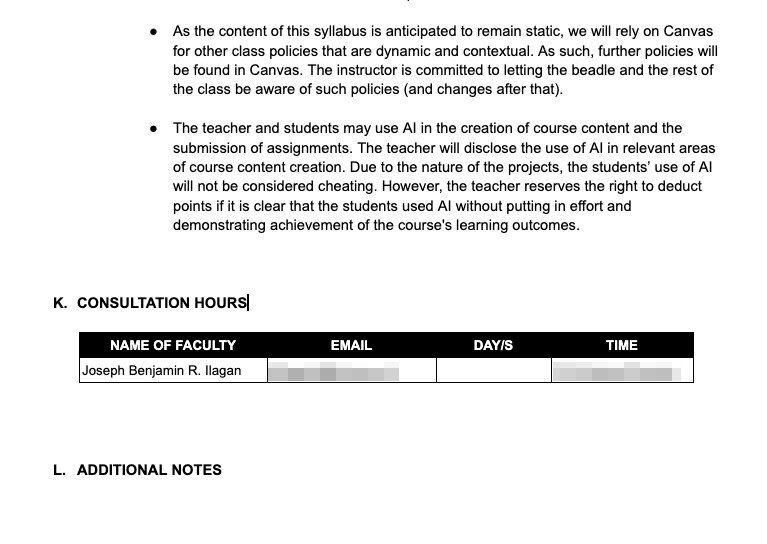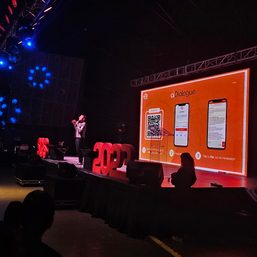SUMMARY
This is AI generated summarization, which may have errors. For context, always refer to the full article.

Students and teachers in the Philippines are making their way across a new landscape, one where education is either made better or worse by artificial intelligence (AI) tools in education.
How do students and teachers approach artificial intelligence and AI tools in the academe?
For some, there is hesitance to accept new technologies like AI in the process of learning or teaching, bringing to mind worries of AI being used to cheat students out of their education. For others, there is a more tacit acceptance of the limitations and possibilities of adding such tools to educators’ and students’ arsenal for learning.
I talked to students and instructors at the Ateneo de Manila University to learn more about how AI is being seen and treated, as well as find out if AI tools are being used in certain contexts.
Apprehension and fascination
Voni Reyes, a student, raised apprehensions about AI. He said most of the information he gets regarding AI comes from social media, such as TikTok and Instagram, and that none of the classes he’s currently taking use AI tools.
A sophomore BS Information Technology Entrepreneurship student at the Ateneo de Manila University, Reyes said he had worries and hopes for using AI tools in learning. “I had a lot of preconceived notions of what AI was,” Reyes said. “It’s represented really differently (by) different groups of people in the media and in the academe, so it’s confusing to have an accurate picture of what AI is because AI can be so many different things.”
“I was worried that AI would take my place in composing essays or making art. I was anxious that, once I started relying on AI, my mind wouldn’t be able to compose the things it composes right now, and that my work would not be grounded on my experience as a person,” he explained.
Reyes added, however, that he was also “fascinated by how AI works, and how I can use it as a way for me to get inspiration for my work, or as a way I could make things more efficient and less erroneous.”
Changing expectations and experience
For Gabrielle Anne Uy, also a BS Information Technology Entrepreneurship sophomore at Ateneo, the tone was entirely different.
A cofounder of an AI-powered design startup, Uy said she initially had concerns regarding data privacy and plagiarism when it came to talk of AI in the academe. Much like someone learning about a new concept, she read up on the matter, and her stance softened towards using AI tools for their intended purpose – as tools meant to help with, rather than replace, work.
Uy said that ChatGPT, the AI tool that creates text outputs based on prompts made by users, is limited in its capabilities even though it is powerful in its own right.
She said, “ChatGPT from OpenAI does not have the human capacity to reflect, distinguish between positive and negative, or even tell you for sure if something is factual or not. It can simply give you certain frameworks that you can refer to when creating something of your own. Granted, students can very easily abuse this and just copy-paste an AI-generated piece of text, but the quality between AI and human work can definitely be distinguished, especially in the Ateneo where most of the core curriculum classes require critical thinking, analysis, and reflection.”
“With this,” Uy added, “I could tell that it was simply a tool; it wasn’t something that you can just magically ask to write a paper from thin air. So, as I started seeing it as such, my expectations and experience wholly changed.”
The changing pace of instruction
These students are learning how AI tools can be useful from their instructor, Joseph Ilagan. He is an instructor under the Quantitative Methods and Information Technology Department of the John Gokongwei School of Management of the Ateneo de Manila University, and is also the program director of the BS Information Technology Entrepreneurship Program.
For him, the changing pace of instruction means embracing but not abusing AI tools like ChatGPT in a classroom setting. While others may see things differently, especially when it comes to those dependent on quizzes and tests for assessing learning, Ilagan said, “To prevent it is doing students a disservice.”
Clearly-defined rules and structure permeate the use of artificial intelligence in his classroom.
In his syllabus, he has made it a point to be open about using AI tools for his courses.

All his syllabi have this proviso: “The teacher and students may use AI in the creation of course content and the submission of assignments. The teacher will disclose the use of AI in relevant areas of course content creation. Due to the nature of the projects, the students’ use of AI will not be considered cheating. However, the teacher reserves the right to deduct points if it is clear that the students used AI without putting in effort and demonstrating achievement of the course’s learning outcomes.”
This is coupled with a workflow where AI serves in the process of course content development. AI tools – those providing automated transcription and grammar checking, like Otter.ai and Grammarly – were part of this workflow, but have been taken over to some extent by ChatGPT. He self-edits, verifies, and adds citations from work he’s searched for using Google Scholar.
Ilagan also uses image-creation AI tools to quickly generate visual content he can use with his syllabi.

AI providing feedback
Ilagan also had specific use cases in instructing students.
“As we helped student groups create case studies for publication, we had ChatGPT generate a starter set of Teaching Notes. With a few tweaks, we were able to come up with something we could use.”
He also said AI was of help when it came time to vetting the ideas of student startups. The startup groups were tasked with using ValidatorAI for their ideas. ValidatorAI is a tool that provides constructive feedback on startup ideas.
For Petagon, a student startup aiming to make pet profile data management easier for pet owners, the tool provided the following output:
“1. Lack of digitalization within the industry causing various economic and general discomforts and inconveniences for pet owners.
2. The size of the market for all pet owners residing within urbanized cities in the Philippines is 5.8 million, which is a conservative percentage of the entire pet owners count of 11.6 million as of 2020.
Feedback: Your business idea has a lot of potential! A few things you could consider are how you will stand out from other pet care businesses, what kind of marketing strategy you will use to attract pet owners, and how you will ensure that your platform is user-friendly.”
Justin Uy and Dione Gan, the cofounders of Petagon, had differing ideas on how to take the feedback from Validator AI.
Gan said the AI tool was “perfect for brainstorming sessions. It does the thinking in terms of pros and cons including the questions you would need to answer” before venturing into a business or an industry.
But Uy said he had expected to get more from the tool, saying, “I’m not so convinced with the feedback it gave because it was too generic and in terms of actual validation, I was hoping it could somehow give a rough estimate of how big the problem is and probably a bit of market info.”
‘ChatGPT is just the tip of the iceberg’
Dr. Roberto Galang, Dean of the John Gokongwei School of Management at Ateneo de Manila University, said students need to be exposed to AI and AI tools in an academic setting.
Teachers also need to discuss AI as a concept – along with the rules that would go along with discussing or using AI tools – no matter what subject they teach, since it’s made certain teaching tools and techniques obsolete.
Galang noted how AI is “materially different” from other previous technologies like the electric motor or cellular phone.
While those increased productivity and created new business models, Galang said, “AI has the capacity to create new knowledge, something that humanity has never seen previously.”
He added, “It is not an exaggeration to say that AI is changing the way science is done. New inventions and discoveries are being made by AI globally, as we now have machines that can condense billions of pieces of information and discover concepts that would take humans generations to figure out, if at all.”
AI is also already here, now, in the Philippines. Galang said Ateneo spoke with local companies using AI to enhance agricultural yields, automate hiring processes, and lower emissions in their factories.
Galang calls ChatGPT “the tip of the iceberg,” and it can only be imagined how much more is beneath the surface. For one thing, AI still needs to surpass its limitations, and also reduce its biases based on what it’s been trained on.
“AI has multiple uses, and Filipino firms need to embrace it today.” he explained. “It’s a great productivity tool that can greatly improve our operations. But, we should use it wisely. The ability of AI to generate correct information is based on both the algorithm and the training data that is used to inform it. Many of these IT tools are developed in the West with training data from foreign sources.”
Galang said the problems surrounding AI have to do with complexity and opaqueness.
As AI becomes more complex, and fewer people understand how it works or can afford to harness its power, it will become more of a commodity. “For most of us, we will be working with a technological black box provided by large global tech giants that the average Filipino manager may not fully comprehend.”
“If we do not at least explain to students the benefits and pitfalls of AI in the classroom,” Galang said, “we are not properly preparing them for the jobs of the present.” – Rappler.com
Add a comment
How does this make you feel?


![[OPINION] My close encounters with AI lies](https://www.rappler.com/tachyon/2023/05/0.jpeg?resize=257%2C257&crop_strategy=attention)

![[Vantage Point] Senate feud shields doubtful costs of new building](https://www.rappler.com/tachyon/2024/07/tl-Senate-feud-shields-cost-senate-building-July-10-2024.jpg?resize=257%2C257&crop=282px%2C0px%2C720px%2C720px)

![[OPINYON] Thesis for sale](https://www.rappler.com/tachyon/2024/06/tl-thesis-for-sale-1.jpg?resize=257%2C257&crop_strategy=attention)
![[The Slingshot] Blunders and mess Sara left behind at DepEd](https://www.rappler.com/tachyon/2024/06/TL-Sara-Duterte-DepEd-June-24-2024.jpg?resize=257%2C257&crop_strategy=attention)

![[OPINYON] Tungkol sa naging viral na social media conjecture](https://www.rappler.com/tachyon/2024/07/thought-leaders-conjecture-07262024.jpg?resize=257%2C257&crop_strategy=attention)

![[EDITORIAL] Apat na taon na lang Ginoong Marcos, ‘di na puwede ang papetiks-petiks](https://www.rappler.com/tachyon/2024/07/animated-bongbong-marcos-2024-sona-day-carousel.jpg?resize=257%2C257&crop=280px%2C0px%2C720px%2C720px)

There are no comments yet. Add your comment to start the conversation.